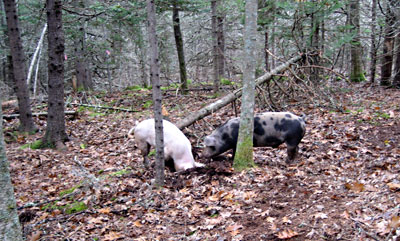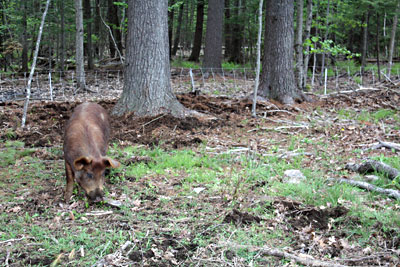 |
| Pigs forage in the woods at the Deer Isle Hostel. Photo by Anneli Carter-Sundqvist |
 |
| A Tamworth pig grazes a wooded area at certified-organic Frith Farm in Scarborough, Maine. Photo courtesy of Frith Farm. |
By Anneli Carter-Sundqvist
The end of our homesteading season has for five consecutive years been marked by the butchering of our pigs. From early July until early December, we’ve cared for these animals as one would for pets: We give them names, we scratch their ears and their bellies, make sure they are dry and warm, and at the end we ensure a fast and respectful death, right in their pen. We process all the meat ourselves and preserve most of it through salt curing and smoking.
After years of working our homestead up to a very high level of food self-sufficiency, our biggest challenge now is to extend that to feeding our pigs. We aim to progress away from a grain diet and supply the majority of the pig feed from our land. Over the past years we have deliberately tried different ways of reaching that goal and we certainly have made strides, but it’s a work in progress. The common practice of feeding livestock commercial grain (including what’s labeled organic) is both unnatural to the animals and a very new practice compared with the many centuries people raised animals without grain. Animal grain relies on fossil fuel for growing the feed crops, for the production and for the distribution logistics. The price fluctuates with the price of the commodities used in the manufacturing process and has increased greatly over the past years. Farmers we know who raise animals on grain say that due to that increase, they have to work harder for the same gains now compared with some years ago.
Each year we’ve raised a couple of pigs, one for us and one for friends of ours. That gives each pig the company of another animal. Two pigs is still a number that we realistically can feed from our land.
For the first couple of years that we raised pigs, we kept them in a small (2,000- to 3,000-square-foot) mobile pen within the clearing of our farm and fed them mostly grain. Even though we often moved them to new ground, the pigs quickly wore it out by rooting. We now keep the pigs penned in our yard only when they are small, to get them used to us and to keep them safe from coyotes. As soon as they are big enough, we use our entire supply of electric fencing to make a 1- to 2-acre pen in the woods, with only a small section of it within sight of our house. For most of the day our pigs run like wild ponies around the spruce and oak trees, digging up roots and rocks, eating acorns and moss and dirt and surely some slugs and salamanders too. If I do feed them a big grain breakfast in the morning, they will stay in their house until I come back with the bucket. But if I cut back or eliminate the feed, they gnaw on rotten roots and logs and chew on bramble leaves. Pigs are scavengers and have evolved to fend for themselves – to forage for food and to be hungry from time to time.
This past year we decided to cut back even more on their grain. We picked up the piglets at the end of July when they were about 10 weeks old, and for the first three-plus months we fed them only four 50-pound bags of grain; many days we didn’t give them any at all. We invested in even more electric wire so that we could easily enlarge and move the pen, and we supplemented their forest floor diet with corn stalks, garden surplus and seaweed. The more rotten these materials were, the more the pigs seemed to like them. Wind-blown apples and dropped acorns are excellent ways to convert a non-edible or less desirable resource into a high-grade food for human consumption, and especially into fats, but this year turned out to be a mediocre apple year and a pretty lean acorn year.
So we learned a few new things. These pigs were hungry, and determined to fend for themselves. Even when given this large area to roam, they dug so hard that we had to close off parts of their pen to keep them from destroying the ground and uprooting birch trees. And even though our success was obvious for the first months, when November came around they had pretty much mopped up what there was to eat, nothing new grew and the apples in the neighborhood had all been eaten by the deer. We depend totally on cold weather for the duration of processing, so we usually can’t kill the pigs before late November; hence we did resort to grain for the last weeks.
We’ve concluded that we can raise pigs on backyard resources, as long as the season provides resources for them. If we had a cooling facility while processing the meat, we could kill them before the natural feed ran out. We would have smaller pigs, since the lean feed really affected the growth rate. We would prefer that to fattening them on grain, since even a medium-sized pig provides enough pork for a year and at the time of slaughter is far easier to move and carry. We could get the pigs earlier in the summer so that they’d be older and to some degree bigger, but age seems to be a marginal factor in the context of size, and this would mean feeding pigs at a time of the year that’s also lean on land-based feed.
Last year we were very clear that we wanted piglets with the same parents as the previous year, since they too were raised largely on natural resources on our land and still grew to a very good size. That leads us to conclude that the breed, in our case Large Black, rather than the amount of grain they are fed, will primarily determine the size and fat proportions.
We could try other practices to become less dependent on grain at the end of the season. We could expand the pen farther into the woods to increase the amount of food available. That would involve extra labor to set up and survey the fence every so often, and even a larger pen would run out of pig feed eventually. In a good apple year, we could stock up on apples and feed them to the pigs over a longer period. When our new orchard is fenced in, we’ll have space protected from the deer where a feeding crop could grow under the fruit trees. Fodder beets, Jerusalem artichokes and squash can grow in pretty rough forest floor soil and provide substantial feed for the pigs.
After those first years of depending so heavily on purchased grain, we realized that we couldn’t keep raising pigs that way financially. Once we started to observe how the pigs behaved when given the option of finding wild food over a large area, we saved money and felt assured and proud that we had raised happy pigs that provided us healthy food.
About the author: Anneli Carter-Sundqvist grew up in the north of Sweden and came to Maine in 2008. She is the author of “A Homesteader’s Year on Deer Isle” (self-published 2014). See www.deerislehostel.com for more information.
